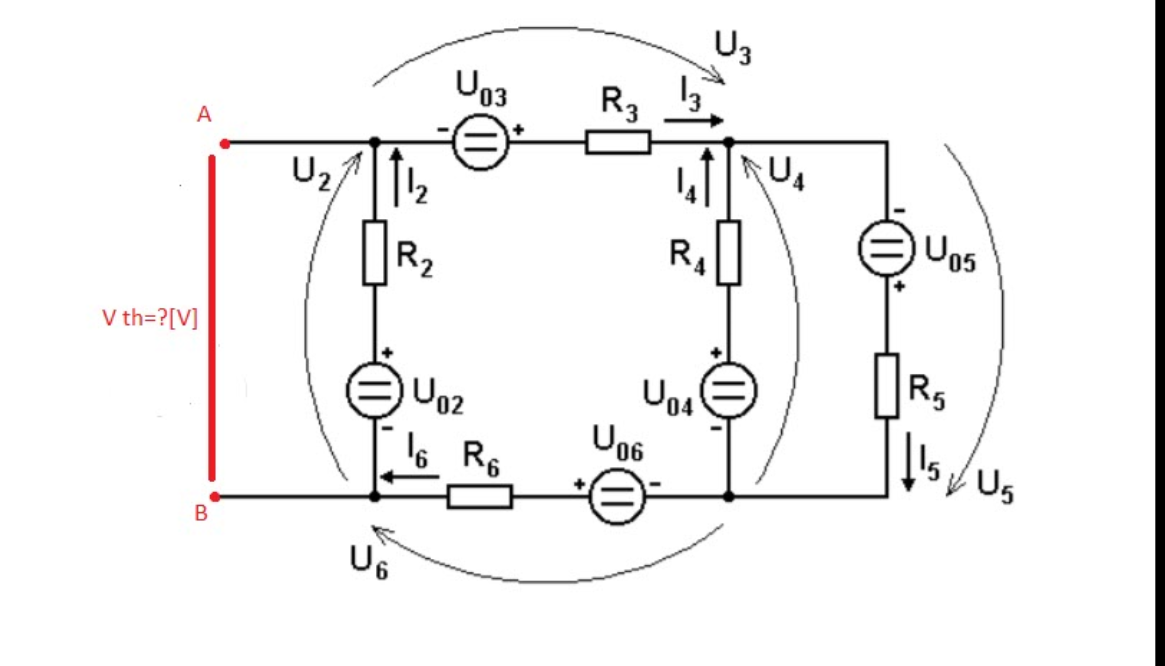KamilAussie
Member
- Location
- Czech Republic
Hey guys, could any of you tell me how to calculate voltage between points A and B? There's way too many sources and it makes me confused. Thank you :?
View attachment 15964
...
Edit: Phooey, still small.

Hi Kamil,Hey guys, could any of you tell me how to calculate voltage between points A and B? There's way too many sources and it makes me confused. Thank you :?
View attachment 15964
I think you are overthinking this... :angel:Hi Kamil,
Once you have calculated the Thevenin equivalalent (both voltage and resistance) for the C-D network (see my earlier post), please post it so that we can check your work before you go on to the next step.
If you are unsure how to do that, let us know, because that part is a pretty simple circuit to find the equivalent of.
I think you are overthinking this... :angel:
All In values are dependent variables. You cannot state an equivalent (other than the one you stated) without using one (or more) of these current variables.Depends on whether or not you are allowed to leave I2 in the answer.
( since I2 is not an independent variable.)
If that answer is acceptable, then just stating that Vth =Vth would be just as satisfactory.
Actually you can.All In values are dependent variables. You cannot state an equivalent (other than the one you stated) without using one (or more) of these current variables.
Yes, I know we can... but why, when it is so much easier stating the answer with an In variable. Now if there were restrictions placed on the answer format, that'd be a different matter... and seemingly what you want to do when there is no need.Actually you can.
You can eliminate all of the I variables and state the answer entirely in terms of the U and R variables.
I was assuming that was what the instructor (or textbook) was looking for.
Think of it as a practical rather than a theoretical problem:
If you build a circuit using the specified ideal voltage sources (U's) and resistors (R's), do you agree that the currents will no longer be variables. You could either calculate or measure them.
BTW, calling them dependent variables is equivalent to saying that they can be determined knowing only the independent variables.
Perhaps you meant mutually dependent, i.e. each current depends on the others, but that is not the case here.
Or did you mean to say that they are independent variables? They are not.
Ye------
Also, I meant dependent variable. All In values are dependent on all Un and Rn values.... no different than E=IR.
But you can't remove all the other components. I2 is dependent on them. Vth = U2 + I2R2 is an acceptable answer when there is no restriction on answer format.My point exactly. If all of the I variables are dependent variables, why use one of them to write the answer?
If I asked you for the voltage between points A and B of the circuit shown but with all of the components except U2 and R2 removed, would you accept the answer
Vth = U2 - I2R2, or would you rather have me just say Vth = U2?
But you can't remove all the other components. I2 is dependent on them. Vth = U2 + I2R2 is an acceptable answer when there is no restriction on answer format.
I acknowledge your points...I was not saying that would be a useful step in the real problem, I was posing an alternate, much simpler problem in which you could trivially calculate I2.
For the trivial problem, I can remove I2 because it is zero in the open circuit case. For the OP's problem I can construct a formula that contains no I values at all, just U and R.
One more argument about why my interpretation may not be the only "acceptable" one but is certainly a more useful one:
With your answer, if someone asks the question of how the value of Vth varies as you change the value of U5, for example, your answer does not give you a clue. My answer would. (At least the limiting behavior for large values of U5 would be clear, even if the formula is messy.)
And lets take it in a slightly different direction: If the problem asked instead for the value of Rth, your formula would be totally useless
since the current through a short between A and B would not be I2.
With my (not yet constructed) formula you would have a voltage that is expressed entirely in U and R values and you could pair that with the short circuit current expressed entirely in U and R values and combine them to calculate Rth.
If you were trying to give a very quick answer to a complex problem on a multiple choice test, you could hope that your answer was one of the ones offered. If it was, then the instructor felt just as you do about it. :happyyes:
But it does not really serve the purpose for a homework question intended to exercise the general process of calculating Vth and Rth in a complex circuit.
I hope we get more feedback from the OP at some point as to what the instructor was trying to get.
I acknowledge your points...
Did you Google at all? Many of us are happy to help fellow member, but I personally like to see you put in some effort to try to figure it out rather than post what looks like a homework problem and ask "how do you get the answer xx ? "
And I acknowledge yours. There are times when the simpler answer is the better answer.

